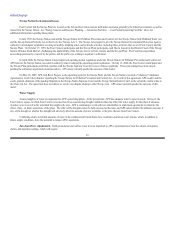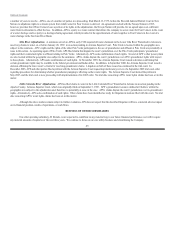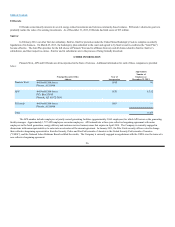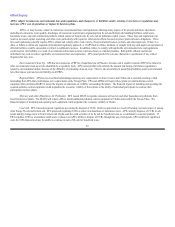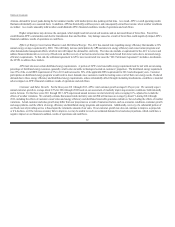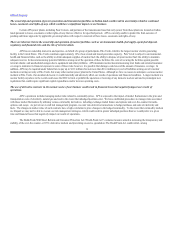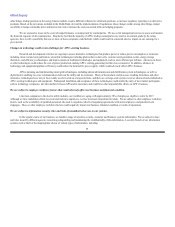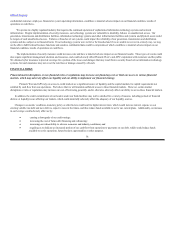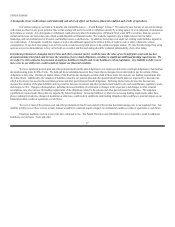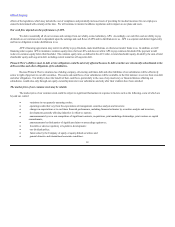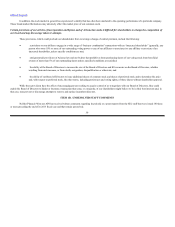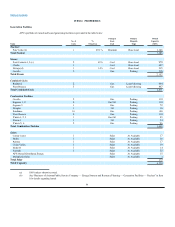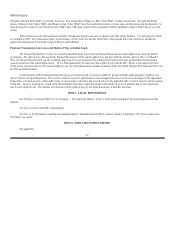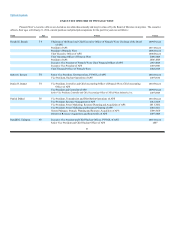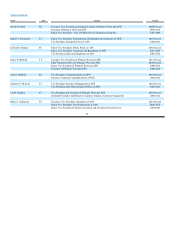APS 2013 Annual Report Download - page 37
Download and view the complete annual report
Please find page 37 of the 2013 APS annual report below. You can navigate through the pages in the report by either clicking on the pages listed below, or by using the keyword search tool below to find specific information within the annual report.
Table of Contents
The ownership and operation of power generation and transmission facilities on Indian lands could result in uncertainty related to continued
leases, easements and rights-of-way, which could have a significant impact on our business.
Certain APS power plants, including Four Corners, and portions of the transmission lines that carry power from these plants are located on Indian
lands pursuant to leases, easements or other rights-of-way that are effective for specified periods. APS is currently unable to predict the final outcome of
pending and future approvals by applicable governing bodies with respect to renewals of these leases, easements and rights-of-way.
There are inherent risks in the ownership and operation of nuclear facilities, such as environmental, health, fuel supply, spent fuel disposal,
regulatory and financial risks and the risk of terrorist attack.
APS has an ownership interest in and operates, on behalf of a group of participants, Palo Verde, which is the largest nuclear electric generating
facility in the United States. Palo Verde constitutes approximately 18% of our owned and leased generation capacity. Palo Verde is subject to environmental,
health and financial risks, such as the ability to obtain adequate supplies of nuclear fuel; the ability to dispose of spent nuclear fuel; the ability to maintain
adequate reserves for decommissioning; potential liabilities arising out of the operation of these facilities; the costs of securing the facilities against possible
terrorist attacks; and unscheduled outages due to equipment and other problems. APS maintains nuclear decommissioning trust funds and external insurance
coverage to minimize its financial exposure to some of these risks; however, it is possible that damages could exceed the amount of insurance coverage. In
addition, APS may be required under federal law to pay up to $111 million (but not more than $16.4 million per year) of liabilities arising out of a nuclear
incident occurring not only at Palo Verde, but at any other nuclear power plant in the United States. Although we have no reason to anticipate a serious nuclear
incident at Palo Verde, if an incident did occur, it could materially and adversely affect our results of operations and financial condition. A major incident at a
nuclear facility anywhere in the world could cause the NRC to limit or prohibit the operation or licensing of any domestic nuclear unit and to promulgate new
regulations that could require significant capital expenditures and/or increase operating costs.
The use of derivative contracts in the normal course of our business could result in financial losses that negatively impact our results of
operations.
APS’s operations include managing market risks related to commodity prices. APS is exposed to the impact of market fluctuations in the price and
transportation costs of electricity, natural gas and coal to the extent that unhedged positions exist. We have established procedures to manage risks associated
with these market fluctuations by utilizing various commodity derivatives, including exchange traded futures and options and over-the-counter forwards,
options, and swaps. As part of our overall risk management program, we enter into derivative transactions to hedge purchases and sales of electricity and
fuels. The changes in market value of such contracts have a high correlation to price changes in the hedged commodity. To the extent that commodity markets
are illiquid, we may not be able to execute our risk management strategies, which could result in greater unhedged positions than we would prefer at a given
time and financial losses that negatively impact our results of operations.
The Dodd-Frank Wall Street Reform and Consumer Protection Act (“Dodd-Frank Act”) contains measures aimed at increasing the transparency and
stability of the over-the counter, or OTC, derivative markets and preventing excessive speculation. The Dodd-Frank Act could restrict, among
34


